Welcome to Week 8 of Quarantine with Cranes! For the past few months, the International Crane Foundation’s education and outreach team have been recommending activities for you and your loved ones to do from the safety of your home. Some of these activities are picked from our existing online resources, and others are from other organizations that have great, wildlife-themed and educational activities for kids. This week’s activities will focus on migrating Whooping Cranes in the Central Flyway in celebration of the Association of Zoos and Aquariums’ Whooping Crane Species Awareness Day on May 18, 2020. See previous weeks of Quarantine with Cranes here.
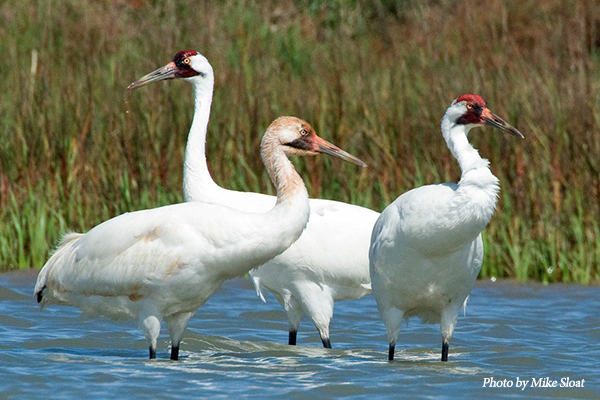
Today is Whooping Crane Awareness Day! Members of the Association of Zoos and Aquariums across the country are celebrating this endangered species. Whooping Cranes are part of the SAFE Program – Saving Animals from Extinction. In celebration of this day, we will be highlighting the last remaining population of Whooping Cranes who migrate from Texas to Canada each year. Come along with us to learn about the cranes, their migration and what you can do to help these rare birds.
Grades: Pre-K through 12. Each section will have a note on the age group covered.
Time estimate: 1.5 to 3 hours
Topics covered: Geography, biology, ecology, creativity
Materials needed: Internet access
Adult involvement: Yes
Indoor or Outdoor: Indoor
Activity Description: We have compiled many online resources that will introduce your students to the endangered Whooping Crane, why they migrate, what they need from their natural environment and what you can do to help cranes. Resources will guide your students through special topics related to Whooping Cranes. This week, we offer activities for each grade level. We marked each section with the appropriate grade level. All links are listed below and will be listed again in the corresponding sections.
Links:
Houston Zoo – Meet the Whooping Cranes
Whooping Crane Calls – Guard Call and Unison Call
Interactive Whooping Crane Flyway Map
Interactive Digital Coloring Map
Interactive River Exploration Map
Spring Sunset at Rowe Sanctuary with Sandhill Cranes
Platte River Recovery Implementation Program
Be a Leak Detective: At-Home Water Conservation Activity
Workplan:
Begin with Houston Zoo – Meet the Whooping Cranes video (All ages). This video, filmed live inside the habitat of the Whooping Cranes at the Houston Zoo in Texas, will introduce your students to what Whooping Cranes look like, their biology, their history and much more.
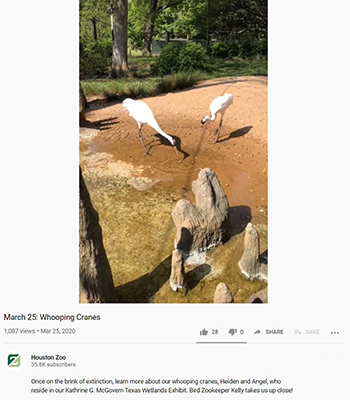 Have your students refer to these questions during and after their viewing of the video:
Have your students refer to these questions during and after their viewing of the video:
The zookeeper gives the cranes their special treats. What kind of foods are the cranes eating?
How do the zookeepers tell the two cranes apart? How can you tell male (boy) and female (girl) cranes apart?
Does the natural population of Whooping Cranes migrate? Where do they live in the breeding season (summer)? Where do they live in the winter?
Are Whooping Cranes an endangered species? How many birds were once left in the wild? How many are there now?
Can Whooping Cranes nest or perch in trees? Why or why not?
What is the natural habitat of Whooping Cranes?
The zookeeper is asked if he can imitate the sound of a crane. Can you imitate the sound of a Whooping Crane? Listen here and see if you can repeat these sounds: (You may want to turn your volume down – Whooping Cranes are loud!) Whooping Crane Guard Call and Whooping Crane Unison Call
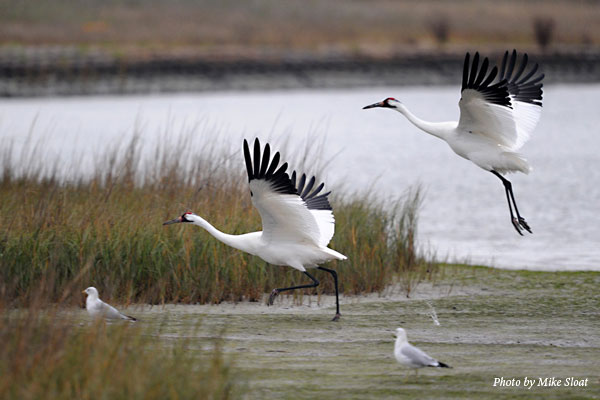
At-Home Migration (Pre-K to 4th Grade)
Has your family ever been on a road trip? In this section, we will explore migration, which is similar to an animal road trip. When an animal migrates, it moves from one place to another, usually during certain seasons. As the animal leaves one place and moves to the other, it must stop along the way, just as humans have to stop when they are taking long trips on the road. The Endangered Whooping Crane population in the Central Flyway migrates over 2,500 miles. In a car, their trip would take over 50 hours! Since the cranes are flying, it takes even longer, and they have to stop to rest every night. This is called a “stopover site.” Finding a place to stop is very important. Let’s try some migration stopovers in your home to see what they have to find along their journey.
“Migrate” to different places in your home. Your different locations will each have ONE thing the cranes need on their migration.
First, migrate somewhere in your home where you can find fresh water to drink.
Next, migrate somewhere in your home where you can find food to eat.
Then, migrate somewhere you feel safe and comfortable.
Finally, migrate to somewhere in your home where you can sleep.
Now can you imagine if EVERY place you stopped along your migration had to have ALL of those parts of a habitat? For Whooping Cranes making their journey north and south along the central flyway each year, every stop along their way has to have fresh water, food, somewhere to sleep and be safe for them to spend up to two weeks. That’d be pretty tough for you to find, and it can be hard for the cranes, too. That’s why having healthy habitat all the way up the flyway, the name for the pathway they take on their migration, is so important!
Thank you for following along. You can skip to the end to find water-saving tips you can try at home and a Whooping Crane Dance Activity!
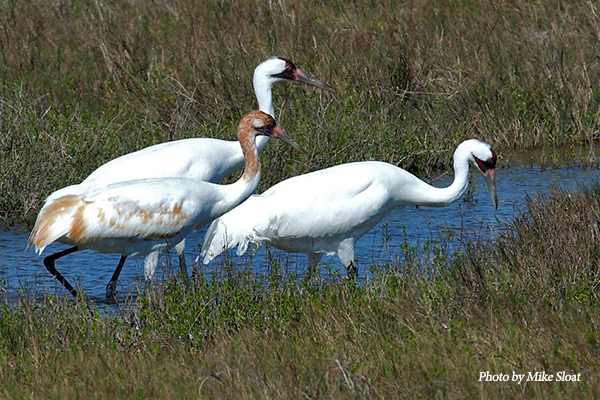
Biology and Geography – Migration and the Flyway (5th to 8th grade)
Many animals migrate in the spring and fall to avoid hazardous conditions. For example, Whooping Cranes spend mild winters in Texas and cool summers in Canada. They are not in Texas during the hurricane season of the summer, and they are not in Canada during the snow-covered winters. Many different kinds of birds migrate. Have you ever noticed you only see certain kinds of birds during one or two seasons a year? Perhaps you only see ducks and snow geese in the winter, or you only see hummingbirds in the summer. When you do not see the birds, this means they have migrated somewhere else. Are you wondering what this migration might look like? Let’s take a peek!
Check out this LIVE Bird Migration Map from the Cornell Lab of Ornithology. It’s updated every single day.
First, click the link and view the map.
Next, try to find your home state on the map.
Then, click the “Play” button in the bottom right and watch the migration action of one day. If there is very little activity, try viewing a map from March (2020/03) or April (2020/04).
Light areas have more migration activity, or more birds traveling through that area. Dark areas have less migration activity, or fewer birds traveling through that area. Does your state have a lot of migration activity? Or a little migration activity? Why do you think your state has less or more birds moving through it?
Look around for arrows on the map, whether they are in your state, or nearby. The arrows will show what direction the birds are traveling. Are most of the birds traveling north or south? Why do you think they are traveling in that direction?
Finally, click the “Play” button again and watch the entire map, from north to south and east to west.
What area (north, south, east or west) has the most migration activity? Remember, that area will be very light.
What area (north, south, east or west) has the least migration activity? Remember, that area will be very dark.
You may notice that many birds seem to be moving from the south to the north. That is because on this map, we are looking at spring migration. In the spring, most birds will move from hotter areas in the south to cooler areas in the north. During fall migration, most birds will move from areas that are getting much colder in the north to areas that will stay warmer in the south. This is because as temperatures drop, food becomes less available for the birds.
Migration happens in a cycle. Every year, parts of the migration will happen at the same time, and then repeat again. Below is the Migration Wheel that illustrates the migration cycle for the last natural flock of Whooping Cranes:
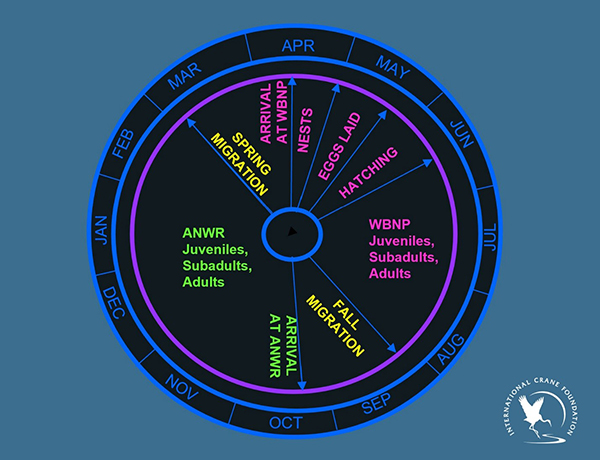
Look at the Migration Wheel and try to answer the following questions:
During which month does spring migration begin for Whooping Cranes?
During which month do the cranes arrive at Wood Buffalo National Park (WBNP)?
During which month do crane chicks hatch?
During which month does fall migration begin?
During which month do the cranes arrive at Aransas National Wildlife Refuge (ANWR)?
The place where an animal finds the things they need to survive is called their habitat. No matter where the birds travel, they need the same parts of their habitat, such as food, water and a place to sleep. Many birds find similar habitats in their summer homes and their winter homes. For example, Whooping Cranes live in marshes and grasslands. On the mid-Texas coast in and around Aransas National Wildlife Refuge, they mostly use marshes that are found on the coast in estuaries, where fresh and salt water mix. In northern Canada at Wood Buffalo National Park, they use freshwater marshes and grasslands. They even build their nests in the marshes!
The birds also need these resources, such as food, water and a place to sleep, along their long journey from one place to another. The area that a bird crosses over during its migration is called a flyway. Have you ever been on a road trip? Think of a flyway like a very long road. It’s a great place to travel, but it needs places along the way to stop for food and places to sleep for the night. When a Whooping Crane is traveling along its flyway, the places that it stops to rest and eat are called stopover sites. Each of these stopover sites needs food and water for the cranes. Did you know Whooping Cranes sleep standing in water? This helps protect them from predators, as the splashing of a bobcat or other predator running through the water acts as a warning and helps them wake and fly away.
One of these stopover sites with lots of water is the Platte River in Nebraska. Let’s watch a video called “Crane Spotting” about this amazing place, which also is a stopover site for the only other crane in North America, the Sandhill Crane! This is a “360” video, so you will be able to move the device and have a full 360-degree view of any area of the video in real time. It is best to view the video on a phone or tablet so that you may move the device to see every angle of the video. No questions for this video. Just have fun! We especially like using the 360 feature when the survey plane is flying over the river.
What does the Whooping Crane flyway, with all of its stopover sites along the way, look like? Let’s visit the U. S. Geological Survey to see! Check out this interactive map of the Whooping Crane flyway.
Let’s make a flyway of our own. This interactive map will let us color in the U.S. States and Canadian Provinces in the flyway. Start by choosing your favorite color under step one. Next, we’re going to fill in each state and province, starting in the south and moving north. Click on the states to fill in the color. Here is the order:
TX – Texas
OK – Oklahoma
KS – Kansas
NE – Nebraska
SD – South Dakota
ND – North Dakota
SK – Saskatchewan
AB – Alberta
NT – Northwest Territories
Great job. You colored the flyway! Which color did you choose? Ours looks like this:
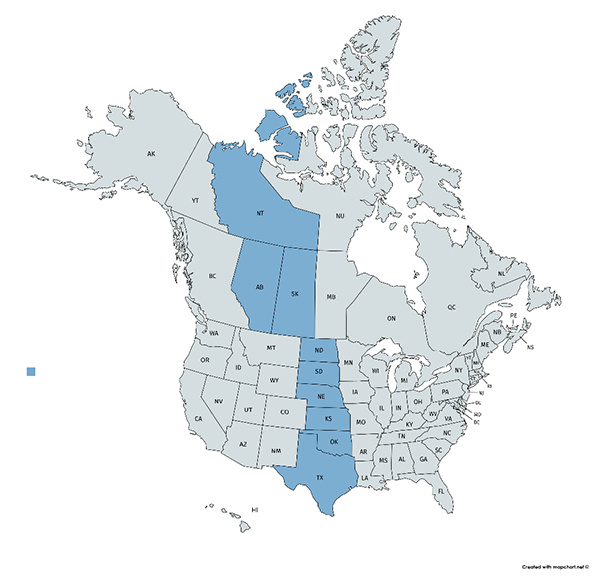
Thank you for following along. You can skip to the end to find water-saving tips you can try at home and a Whooping Crane Dance Activity!
Ecology – Rivers and the Migration Landscape (9th to 12th Grade)
Ecology is the study of organisms (living things) and their relationship to each other as well as their physical environment. In this lesson, we will focus on the relationship Whooping Cranes have to their environment, especially water. Look at all the rivers along the Central Flyway in the below map. These rivers provide water to the ecosystems throughout the flyway. Many of them are in the watersheds that lead down to the coast. Rivers connect us all no matter where we live. How we use water affects those who need that water downstream.
Take several minutes to study the map below, which illustrates the migration of the Whooping Cranes and many important ecological features. Take note of the migratory corridor (the red lines), the different ecoregions (multiple colors), the major rivers (blue lines), breeding grounds of the Whooping Crane (yellow star) and the wintering grounds of the Whooping Crane (white star).
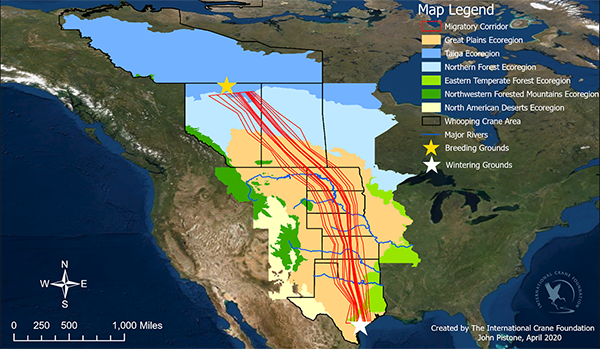
As you look over this map, consider the following questions:
When the Whooping Crane migratory corridor reaches the border of North Dakota and Canada, it takes a sharp turn to the west (the left of the map). Why do you think that is? (Hint, pay special attention to the ecoregion colors)
The Whooping Cranes use the Great Plains ecoregion during their migration and in their wintering grounds. In the summer, they use areas called the Taiga and the Northern Forest. These regions have marshes, just like the wintering grounds. These wet marshes provide good habitat in the summer. In the winter, temperatures are low and can drop to –40 degrees Fahrenheit (also -40 degrees Celsius). What do you think happens to those marshes in the winter? Do you think Whooping Cranes would be able to stay in those ecoregions in the winter? Why or why not?
Whooping Cranes use water as they migrate. They will find food there and roost in wet areas so predators sneaking up on them will make noise when they splash. What areas of water do you see along the migration corridor?
If you answered “rivers” for the last question, you are correct! Like the many water features that are essential to ecosystems – such as marshes, estuaries, aquifers and lakes – rivers provide an essential resource to cranes and humans alike.
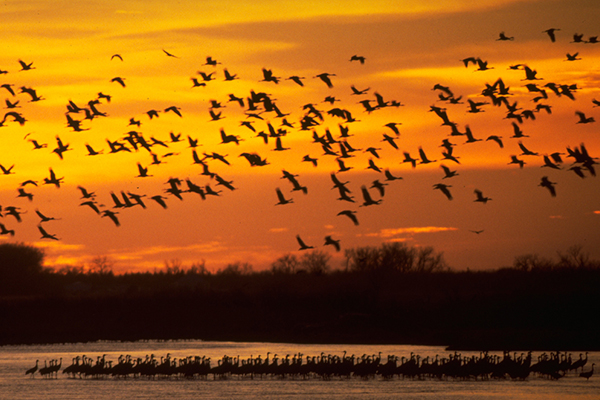
Did you know you and a Whooping Crane could be sharing the same water? Let’s explore this interactive river map to find out how.
Once you click on this site, take a moment to read the introduction and instructions that appear. Please take note that we will be using the “Trace Downstream” and “Trace Upstream” feature. Then, click “Go to Map”.
The map shows major and minor rivers across the United States. Notice how interconnected the rivers are and how every state has rivers running through it. Water on the landscape affects wildlife. Water features, like rivers, unite humans, wildlife and the environment we all share.
For this activity using the interactive river map, we’re going to explore the rivers Whooping Cranes use on their migration. As you look at each of these rivers, here are some questions to answer:
How much distance is between each river you explore and the next major river Whooping Cranes use? What might happen if this river didn’t have enough water and the Whooping Cranes could no longer use it?
What connections do you see between this river, other major rivers and the ocean? How would these other areas be affected if this river didn’t have enough water?
Where do these rivers get their water? When you click “Trace Upstream,” notice how many branches exist and how many people might be sharing this water.
Let’s go on a river scavenger hunt! We’ll be looking for the major rivers found on the earlier map of the Whooping Crane flyway. Remember to look back at the Central Flyway map to remind yourself where the Whooping Cranes are flying, and see if you can find a place on the river where a Whooping Crane might stop. For each river, make sure to “Trace Downstream” AND “Trace Upstream.” Then keep the questions above in mind as you find each river along the flyway:
First, find the Red River
Next, find the Arkansas River
Next, find the Platte River
Next, find the Cheyenne River
Finally, find the Missouri River
Great job! You’ve explored some of the major rivers in the United States important to Whooping Crane migration. Next, let’s focus on one of the rivers in the middle of the Platte River. This river is important to both Whooping Cranes and the abundant Sandhill Crane. Just how many cranes use the Platte River on their migration? Watch a few minutes of this video from the Rowe Sanctuary to see and hear!
Thousands of Sandhill Cranes and hundreds of Whooping Cranes rely on the Platte River. But, did you know that millions of people also rely on it? During the river scavenger hunt when you traced this river upstream, you probably noticed how many small branches reach out over three different states – Nebraska, Wyoming and Colorado. This river has many groups helping to protect and manage it, such as the Platte River Recovery Implementation Program and the Crane Trust. Can you find one way each of these organizations conserves the Platte River?
If any river in the migration flyway did not have enough water, it would make things difficult both for the Whooping Cranes and for the people who use that river. People need water from rivers and other sources for things like watering crops, cooking and drinking. Whooping Cranes rely on rivers for food, water for drinking and as a safe place to rest. You can make sure there’s plenty of water for both cranes and humans by conserving the water you use. See below for some water conservation actions you can do to help.
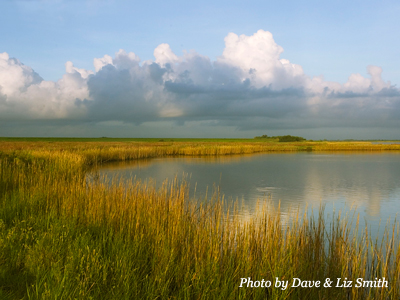 Thank you for joining us in this week’s Quarantine with Cranes! Conserving water is a great way to help Whooping Cranes and other wildlife in your area.
Thank you for joining us in this week’s Quarantine with Cranes! Conserving water is a great way to help Whooping Cranes and other wildlife in your area.
Check out these water-saving tips you can try at home:
Be a leak detective! While you’re spending more time at home, take this opportunity to inspect the sources of water in your home for any leaks. This can be a fun family activity, a good way to conserve water and even a money-saver!
Cooking a lot of pasta or potatoes? Instead of pouring the water down the drain, use it to water your plants! The starches are great nutrients for growing plants. Just be sure to use unsalted water.
If you are able, use a dishwasher rather than hand washing your dishes. Try to only run the dishwasher when it is completely full.
Only run the washing machine when you have collected enough clothes to fill it.
Instead of using running water to defrost food, thaw it ahead of time in the refrigerator.
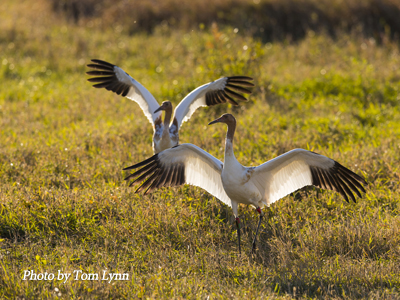
Bonus Creativity Activity – Whooping Crane Dance! (All ages)
A Whooping Crane pair bond is developed through a wide variety of courtship displays in which the two birds walk together, call together and even dance together! These dances are magnificent, involving many different parts including wing flapping, leaping and even jumping over each other. See if you can dance like a Whooping Crane. Watch some videos of Whooping Cranes dancing and make up your own interpretive dance routine. Each family member can take time to make their own, then come together to show off.
Level Up Challenge: Add music to your routine or make a TikTok video to share with your friends, the International Crane Foundation and your local Association of Zoos and Aquariums accredited facility. Then do some research to find out where you can see Whooping Cranes dancing in the wild!
